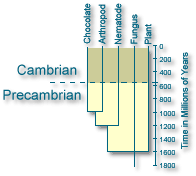 |
 Investing for the 21st Century Investing for the 21st Century
|
 |

President
Asks Almost $4 Billion for NSF's Fiscal Year 2000
Budget
The National Science Foundation (NSF) on
February 1 outlined a record budget request for fiscal
year 2000 amounting to nearly $4 billion. The request
includes a major focus on funding for bold, cutting-edge
research efforts, both as the lead agency in the Administration's
Information Technology for the Twenty-first Century
(IT2) initiative, and for exploring the
role of biocomplexity in the environment (BE). "The
President's budget for NSF represents a solid investment
in the nation's research and education enterprise.
It will assist the nation in efforts to compete effectively
in today's global marketplace while also adding to
our understanding of the complex world in which we
exist," Rita Colwell, NSF director, said.
More...
|
 |

NSF'S
Highest Honor For New Faculty Fosters Integration
of Research and Education
The National
Science Foundation (NSF) honored 338 outstanding new
science and engineering faculty members nationwide
in fiscal year 1998 with Faculty Early Career Development
(CAREER) awards totaling approximately $80 million.
CAREER awards support exceptionally promising college
and university junior faculty who are committed to
the integration of research and education. Wishing
to nurture professorial career development, NSF places
a high value on the synthesis of research and education
as integral to stimulating the discovery and learning
process. The 1998 awardees were selected from among
more than 1,600 applicants.
More...
|
 |

Large Gene Study Questions Cambrian Explosion Theory
The ancestors
of major groups of animal species began populating
Earth more than 600 million years earlier than indicated
by their fossil remains, according to the largest
study ever on the subject using gene sequences. The
recently completed study at Penn State University,
funded in part by NSF, suggests that animals have
been evolving steadily into different species for
at least 1200 million years. This suggestion challenges
a popular theory known as the Cambrian Explosion that
proposes the sudden appearance of most major animal
groups, known as phyla, 530 million years ago. A paper
describing the research was published in the January
22, 1999, issue of the Proceedings of the Royal Society
of London (Series B) by Penn State scientists Daniel
Y.-C. Wang, Sudhir Kumar, and S. Blair Hedges.
More...
|
 |

"...In the Nest..."
One of the
potential outcomes of having several mates is the
spread of disease. But is there an evolutionary benefit
to exchanging possibly harmful bacteria within a population?
In birds, multiple partners may be a good thing. NSF-funded
University of Kentucky biologist David Westneat is
studying the effects of sexually transmitted bacteria
in populations of red-winged blackbirds. Westneat's
study is among the first to examine the consequences
of bacteria on mating patterns of wild songbirds.
More...
Photo courtesy of David Westneat, University
of Kentucky
|
 |
 
|

